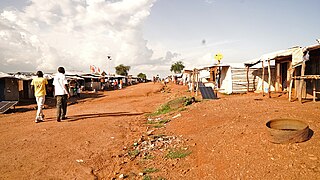
The Kakwa people are a Nilotic ethnic group and part of the Karo people found in north-western Uganda, south-western South Sudan, and north-eastern Democratic Republic of the Congo, particularly to the west of the White Nile river.

Adjumani District is a district in Northern Uganda. Like most other Ugandan districts, it is named after its 'chief town', Adjumani, where the district headquarters are located.
South Sudanese refugees are persons originating from the African country of South Sudan, but seeking refuge outside the borders of their native country. The world's youngest independent country has a recent and troubled history of prolonged conflicts and ecosystem mismanagement such as overlogging, which has led to desertification. These forces have resulted not only in violence and famine, but also the forced migration of large numbers of the population, both inside and outside the country's borders. South Sudan was cited as the largest refugee crisis in 2016, being the world's third largest, followed by Syria and Afghanistan. As of 2022, the UNHCR estimated that there were 2.4 million refugees under its mandate originating from South Sudan, making the country the fifth largest source of refugees.
Pagirinya Refugee Settlement is a refugee camp in Eastern Adjumani District in Northern Uganda.

Bidibidi Refugee Settlement is a refugee camp located in Yumbe District's West Nile sub-Region in Uganda. It is one of the world’s largest refugee settlements, housing approximately 285,000 refugees fleeing conflict in South Sudan as of late 2016. In 2017, and refugees from DR congo. it was described as the largest refugee settlement site in the world, and in 2023, it was labeled "Africa’s largest refugee camp" by The Guardian.
Imvepi Refugee Settlement is a refugee camp in Terego District in West Nile Sub Region of northwestern Uganda.
The Palorinya Refugee Settlement is a refugee camp in the Moyo District of the Northern Region of Uganda. The majority of the population fled the civil crisis in South Sudan in 2016.
The Elema Refugee Settlement is a refugee settlement in Adjumani district, westnile sub-region of Uganda. Elema was established in 1992 and stands to be the oldest refugee settlement out of the total of nine settlement in Adjumani district. The settlement is composed entirely of refugees from the Kuku tribe of South Sudan. The Kuku speak a Bari dialect, also called Kuku. They are chiefly a farming people relying on mixed farming. Following a UNHCR-led repatriation of South Sudanese refugees in 2008 from Uganda, the Kuku ethnic group in Elema declined to be repatriated.

Alere 2 Refugee Settlement is located in Adjumani District in the Northern Region of Uganda.
Baratuku refugee settlement is a refugee settlement in the Adjumani district Uganda
Mungula II Refugee Settlement is a refugee camp found in Adjumani District Itirikwa subcounty in Northern Uganda.
Olua I Refugee settlement is a refugee camp in eastern Adjumani District in Northern Uganda. The Refugee settlement has its primary country as Uganda and other country south Sudan.
Mungula refugee settlement is located in Adjumani district in northern Uganda on the border with South Sudan.
Mirieyi refugee settlement is a refugee camp in Ofua Sub County in the Adjumani District of Uganda.
Oliji refugee settlement is a refugee camp in Adjumani District of Uganda.

Boroli refugee settlement is a refugee camp located in the Pakele Sub County of Adjumani District Northern Region, of Uganda.
Ayilo 2 refugee settlement is one of the refugee camps in Adjumani District in the Northern Region of Uganda.
The Agojo refugee settlement is a refugee camp in the Adjumani District of Northern Uganda, opened in 2016 in response to an influx of South Sudanese refugees fleeing the insecurity in their country. It is located 16 kilometres (10 mi) west of the town of Adjumani.

The Maaji refugee settlements are three refugee camps located in Adjumani District in the Northern Region of Uganda, established in 1997. In June 2018, there were 41,764 registered refugees, accounting for 10% of the district's total population. It has primarily admitted refugees from the Second Sudanese Civil War and the ongoing South Sudanese Civil War. The settlements have been attacked several times by the Lord's Resistance Army, along with other camps in the region such as the Baratuku refugee settlement.
Ayilo 1 refugee settlement is a prominent refugee camp located in Adjumani District, situated in the Northern Region of Uganda.






